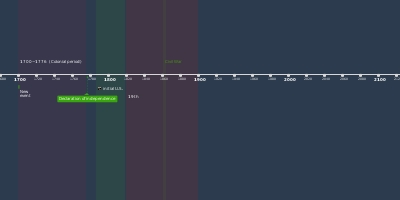1700~1776 (Colonial period) (1 ene 1700 año – 3 jul 1776 año)
Descripción:
The colonial economy of what would become the United States was pre-industrial, primarily characterized by subsistence farming. Farm households also were engaged in handicraft production, mostly for home consumption, but with some goods sold.[6]The market economy was based on extracting and processing natural resource and agricultural products for local consumption, such as mining, gristmills and sawmills, and the export of agricultural products. The most important agricultural exports were raw and processed feed grains (wheat, Indian corn, rice, bread and flour) and tobacco.[7] Tobacco was a major crop in the Chesapeake Bay region and rice a major crop in South Carolina. Dried and salted fish was also a significant export. North Carolina was the leading producer of naval stores, which included turpentine (used for lamps), rosin (candles and soap), tar (rope and wood preservative) and pitch (ships' hulls). Another export was potash, which was derived from hardwood ashes and was used as a fertilizer and for making soap and glass.
The colonies depended on Britain for many finished goods, partly because laws prohibited making many types of finished goods in the colonies. These laws achieved the intended purpose of creating a trade surplus for Britain. The colonial balance trade in goods was heavily in favor of Britain; however, American shippers were able to offset roughly half of the goods trade deficit with revenues earned by shipping between ports within the British Empire.[8]
The largest non-agricultural segment was ship building, which was from 5 to 20% of total employment.[9] About 45% of American made ships were sold to foreigners.[6]
Exports and related services accounted for about one-sixth of income in the decade before revolution.[10] Just before the revolution, tobacco was about a quarter of the value of exports. Also at the time of the revolution the colonies produced about 15% of world iron, although the value of exported iron was small compared to grains and tobacco.[11] The mined American iron ores at that time were not large deposits and were not all of high quality; however, the huge forests provided adequate wood for making charcoal. Wood in Britain was becoming scarce and coke was beginning to be substituted for charcoal; however, coke made inferior iron.[12] Britain encouraged colonial production of pig and bar iron, but banned construction of new colonial iron fabrication shops in 1750, but the ban was mostly ignored by the colonists
Añadido al timeline:
fecha:
1 ene 1700 año
3 jul 1776 año
~ 76 years
